The Scientific Process
Scientific Method is a series of steps that is used to answer a question or solve a problem .
The Scientific Process:
Steps in the Scientific Method
- 1. Collecting Observations
- 2. Problem-Asking Questions –research
- 3. Forming Hypothesis & Making Predictions
- 4. Experimenting
- 5. Collecting Data
- 6.Drawing Conclusions
6 Steps to the Scientific Method:
- The question or problem is based on observations .
- Example: My neighbor’s plants growing
better than mine.
- 2) Research
- Explore resources that may have information about that question or problem.
Example: I know that my neighbor uses fertilizer on her plants and I don’t.
- 3) Hypothesis
- A possible explanation or answer to the questions.
- Prediction based on observations and questions.
-Fertilizer makes plants grow faster.
- 4) Experiment=test
- A planned procedure to test a hypothesis.
- An experiment tests the hypothesis.
- A hypothesis tests only one factor (variable) at a time.
- Example: I test to see if fertilizer has an effect on plants.
The Scientific Process:�6 steps to the scientific Method�4. Experiment � There is a Control group and an Experimental Group .
The control group is the group getting all the factors except the experimental treatment.
The factors are also called constants.
Constants are kept the same for all the groups being tested in the experiment.
The experimental groups are the groups getting experimental treatment . The group being tested in the experiment.
- Placebo an inert substance given to the control group and should have no effect on the control group .
- The purpose of a placebo is to eliminate biases . Placebos are often given in experiments involving people because the attitudes of people can be a factor in the experiment.
- Ex: A pharmaceutical company may want to test the effects of a blood pressure medication. The experimental group would receive a pill with the medication, but the control group would receive a placebo, a pill that does not contain any medication. The group
members would not know if
they received a pill with the
medication or a pill with no
medication. People who
think they have been given
a medication, even if it is a
placebo, can sometimes
improve a health condition
just because they believe
that the medicine they receive will help them. This is called the placebo effect.
- Sometimes, the doctors don’t know which participants have the placebo and which have the experimental drug . This keeps the doctors from treating the participants differently. This is called a double-blind study , and it helps to eliminates biases .
The Scientific Process:� 6 Steps to the Scientific Method:
Independent —the variable being tested . The
variable that changes in the experiment. It is on
the X-axis of a graph.
TIX=TESTED INDEPENDENT X-axis
- Example: The independent variable would be the fertilizer.
Dependent —the variable being measured/recored at the end of the experiment. It is on the Y-axis of a graph. (depends on the independent variable)
DRY=DEPENDENT RECORDED Y-axis
- Example: The growth of the plants would be the dependent variable.
X-axis; independent variable
Y-axis; dependent variable
- Data from the experiment is collected, recorded, and analyzed.
Example: I record the differences in growth of the plants.
- 6) Conclusion – what you found
- Example: My experiment showed that plants with fertilizer grew faster and bigger.
- * If your hypothesis was accepted, problem solved.
- *If your hypothesis was rejected, the experiment failed.
- **Don’t give up!! Do more research. Don’t trash your info; build from it!
- ****For a conclusion
- to be meaningful or
- valid, the experiment
- must be repeatable
- with the same
- results!!****
- Models, such as graphs , can be
- used to illustrate your
- conclusions in a visual manner .
Reliability vs. Validity
- Reliability is whether or not a test produces stable and consistent results.
- Reliability is another term for consistency .
- If one person takes the same personality test several times and always receives the same results, the test is reliable.
- Validity is how well a test measures what it is meant to measure.
- A test is valid if it measures what it is supposed to measure.
- If the results of the personality test claimed that a very shy person was in fact outgoing, the test would be invalid .
- Reliability and Validity are independent of each other.
- A measurement maybe valid but not reliable, or reliable but not valid.
- Suppose your bathroom scale was reset to read 10 pound lighter. The weight it reads will be reliable(the same every time you step on it) but will not be valid, since it is not reading your actual weight.
Put the following in order according to the scientific process:
- Hypothesis, problem, conclusion, research, observation, experiment and data collection
- 1_____________________
- 2 _____________________
- 3 _____________________
- 4 _____________________
- 5 _____________________
- 6 _____________________
Theory —a set of related hypotheses that have been tested and confirmed many times by many scientists.
A theory unites and explains a broad range of observations. It is not the same as the general definition—it does NOT imply a lack of knowledge or a guess.
Scientific Method Cont.
- Hypothesis —an explanation for an observation that can be tested by additional observations or experimentation.
- Prediction —the outcome that is expected if a hypothesis is correct.
- Observation —the act of noting or perceiving objects or events using the senses.
Elements of a Good Experiment
- Increased Population Size —the more subjects you have the better your experiment will be . It helps to eliminate random errors.
- Control group — a predictable group that you “know” what to expect ; receives no experimental treatment. Used for comparison with variable group
- Experimental group — a group containing the independent variable ; compared to the control group. Should be identical to control group with only one thing (the independent variable) different.
Independent variable — the ONLY difference between the control group and the variable group. Usually, the independent variable is what you are testing the effect of in your experiment (Factor that is varied)
Dependent variable — the specific result you are looking for to prove your hypothesis . This is usually something you are measuring, the effect of the independent variable. (Factor that is measured)
Dependent Variable
What is measured
Independent Variable
What can change
- Collecting Observations
- Asking Questions
- Forming Hypothesis & Making Predictions
- Experimenting
- Drawing Conclusions
Rules and Guidelines for Graphing :
- What is a graph? Graphs provide visual summaries of data to demonstrate relationships between variables in an experiment. A well-constructed graph usually communicates experimental findings better than a data table. They are constructed to help analyze experimental results and predict future trends in the experiment.
- There are three main types of graphs we will use in this class: Line graph, Bar graph, and Pie chart . Graphs have two axes: the horizontal axis (x-axis) where the independent variable is usually plotted; the vertical axis (y-axis) where the dependent variable is usually plotted .
Y axis ( Dependent Variable )
X axis ( Independent Variable )
- 1) Line Graph- Used to show continuous data . Ex: height of plants, amount of fertilizer; length in
time. This is
information that
- 2) Bar Graph- Used to show data that is categorized or counted. Ex: months of the year, brands of gasoline, number of children, kinds of animal or color. This is information that stops.
- 3) Pie Chart- Used when you want to show percentages. The size of each “slice” is proportional to the percentage of that item, and all the of the “slices” in the pie can be added together to equal 100 percent.
- These are labeled pictures that show a relationship between objects or parts .
- They are used to communicate data in an experiment or to give general information about a biology topic.

- My presentations

Auth with social network:
Download presentation
We think you have liked this presentation. If you wish to download it, please recommend it to your friends in any social system. Share buttons are a little bit lower. Thank you!
Presentation is loading. Please wait.
Scientific Problem Solving
Published by Hester Young Modified over 5 years ago
Similar presentations
Presentation on theme: "Scientific Problem Solving"— Presentation transcript:
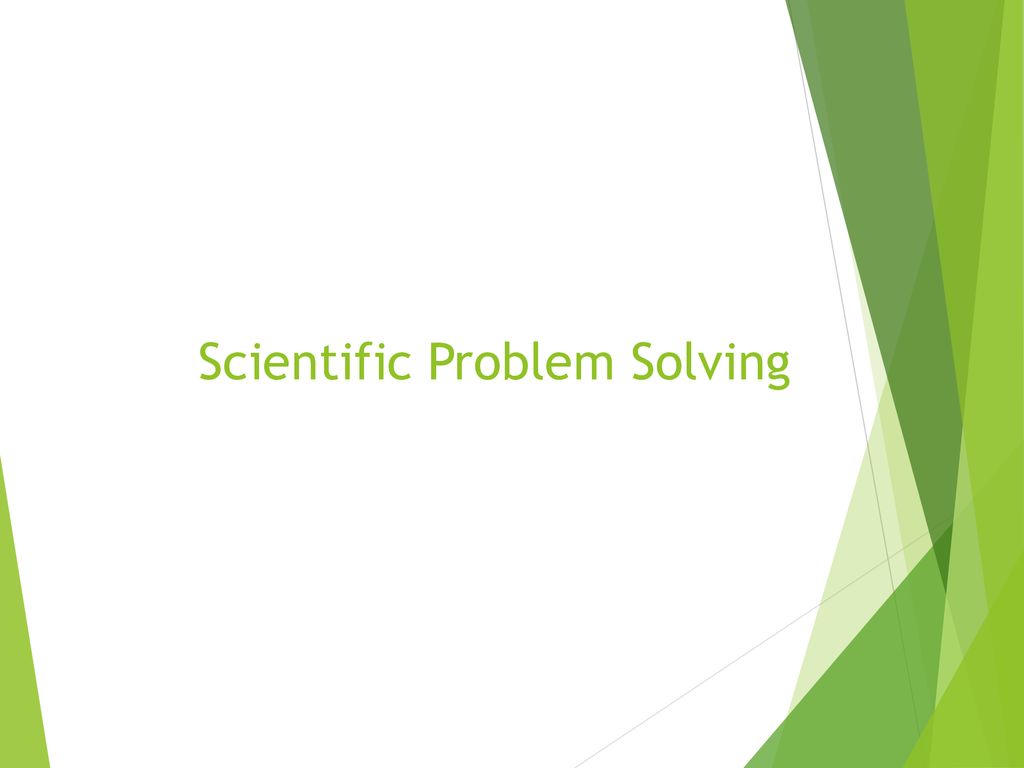
Exploring Physical Science

Chemistry UNIT 1. Susie Smith August, 2010 Chemistry is the study of matter.

Unit 1 Introduction Chapter 1

Scientific Measurements

Chapter 1 The Nature of Science. I. How Science Works Science – the process of trying to understand the world Science – the process of trying to understand.

SCIENTIFIC METHOD #1 : IDENTIFY THE PROBLEM OR ASK A QUESTION BASED ON AN OBSERVATION.

1.1 Objectives Explain how science and technology are related. List the major branches or natural science and describe how they overlap. Describe the.

The World of Physical Science. » __________ is a process of gathering knowledge about the natural world. » Can you give some examples of sciences?

3 branches of science.

Unit 1 The Nature of Science. Unit 1 Learning Targets By the end of this unit you should be able to: –Discuss science and its major branches –Explain.

Chapter 1 The Study of Our World. The Way Science Works Science Observing, studying, experimenting to find the way that things work and why Technology.

Password: f22dbf04e5 Science Fundamentals.

“Intro to Science” A. What is science? 1. Science is the process of observing and studying everything in the natural world. B. Why do we study science?

Earth Science with Mr. Smith. What is Science? Science is a process that uses observations and investigation to gain knowledge about events in nature.

Science & Measurement A. The Nature of Science * 1. Science is the total collection of knowledge gained by man’s observation of the physical universe.

Science Unit 1 Unit Contents Section 1 - The Methods of Science Section 2 – Measurement and Mathematics.

UNIT 1: THE NATURE OF SCIENCE. GOAL OF SCIENCE TO EXPLAIN AND UNDERSTAND THE WORLD AROUND US –TECHNOLOGY – USING SCIENTIFIC KNOWLEDGE AND TOOLS IN A USEFUL.

Nature of Science TEST REVIEW.

Metric Tools Metric History 100 Convert This! Units and Prefixes Metric Vocab Scientific Method

Introduction to Science By: Mr. Kauffman. Outline What is science? Types of sciences Systems of measure Scientific measuring Scientific measuring – length.
About project
© 2024 SlidePlayer.com Inc. All rights reserved.
- Preferences

Scientific Thinking and Problem Solving - PowerPoint PPT Presentation

Scientific Thinking and Problem Solving
Science does not absolutely prove anything - only provides data for the existence of phenomena. ... rationalism: the practice of logical reasoning ... – powerpoint ppt presentation.
- No way of thinking or, however ancient, can be trusted without proof.
- Henry David Thoreau
- The exploration of nature
- Scientists look for organization in nature and try to explain it.
- Science does not absolutely prove anything - only provides data for the existence of phenomena.
- Scientific Law
- Scientific Theory
- Scientific Hypothesis
- Natural phenomenon observed, tested and explained
- Repeatably observed over and over again without exception
- Greatest degree of certainty
- Ex. Law of Gravity
- Many facts, ideas and explanations
- Unified into a central explanation
- High degree of certainty among scientist studying problem
- Subject to continued revision and testing
- Ex. Global Warming
- Variety of tentative or possible explanations for an observation
- Used to generate questions and tests for the hypothesis
- Often changing as hypothesis is refined
- Ex. Mass extinctions terrestrial, extraterrestrial or natural causes
- Hypothesis an educated guess as to the outcome of a particular experiment or phenomenon.
- Observation a set of data based on measurements obtained using one or more of the five human senses, including instrumentation designed to enhance those senses, such as telescopes or microscopes.
- Data a set of observations
- Experiment a test designed to eliminate a possible outcome or to verify the occurrence of a phenomenon
- Prediction statement of a particular outcome that must be true if a hypothesis is true.
- Observation and development of a meaningful question to identify a significant problem. The question must be stated in a way that it is possible to answer it.
- Gather information to solve the problem or further investigate.
- Propose a solution hypothesis
- Test the hypothesis
- Experiments
- Make further observations
- If the hypothesis fails it is rejected or modified
- If the hypothesis is not rejected it is tested over and over. If it remains valid through many tests it becomes knowledge.
- Formulating questions about observed phenomenon.
- Must eliminate realm of possibilities and focus the question.
- Probable answers are explored
- Generate questions (hypotheses) as why the car will not start
- Information must be sensible, measurable, and repeatable, so that others can make the same observations
- Information is gathered from the reliable sources (library) or past (empirical) experiences.
- Evidence that one can see, hear, touch, taste, or smell it is evidence that is susceptible to one's senses.
- Foundation for reliable knowledge What you can see and experience.
- Contrast to
- Authoritarian Evidence Information passed through sources such as Teachers.
- Circumstantial Evidence Motive, Cause and Opportunity
- Car wont start
- What have I observed, heard, smelled that may be cause of the problem
- Gather reliable Information
- Hypotheses and Null Hypothesis
- Informed, testable, and predictive solution to a scientific problem
- Developed Through
- Deductive Reasoning
- Inductive Reasoning
- Deduce facts by eliminating all possible outcomes that do not fit the facts
- All possible outcomes are eliminated until only one possibility remains
- Car will not start
- Test all components
- Component not working is the problem
- Is this a practical approach?
- Building a house of cards
- Every test occurs the same so it must be true
- Cant test every system on the car
- Test what we believe is the problem
- If it fails the problem is identified however..
- Observations
- Assumptions
- Process of arriving at a conclusion through the use of logic.
- Differs from Emotional, Hopeful and Wishful Thinking that use bias and personal belief.
- Refine and develop through rational thinking
- If I leave it alone it will start tomorrow
- It will not start because I have an important task to accomplish
- Test the Hypothesis
- Alternative ideas and hypotheses
- Bias of Interpretation
- The constant questioning of beliefs and conclusions.
- Test the logical consequences to see if your beliefs match objective reality.
- Look for political, monetary and other motivations that may bias information.
- Solution for car expensive when repair is not necessary
- Accept, Refine or Reject the Hypothesis
PowerShow.com is a leading presentation sharing website. It has millions of presentations already uploaded and available with 1,000s more being uploaded by its users every day. Whatever your area of interest, here you’ll be able to find and view presentations you’ll love and possibly download. And, best of all, it is completely free and easy to use.
You might even have a presentation you’d like to share with others. If so, just upload it to PowerShow.com. We’ll convert it to an HTML5 slideshow that includes all the media types you’ve already added: audio, video, music, pictures, animations and transition effects. Then you can share it with your target audience as well as PowerShow.com’s millions of monthly visitors. And, again, it’s all free.
About the Developers
PowerShow.com is brought to you by CrystalGraphics , the award-winning developer and market-leading publisher of rich-media enhancement products for presentations. Our product offerings include millions of PowerPoint templates, diagrams, animated 3D characters and more.

Problem Solving Powerpoint Templates and Google Slides Themes
Unlock your creative problem-solving skills with our collection of visually stunning and highly versatile presentation templates designed to captivate your audience.
Explore Free Problem Solving Presentation Templates

Minimal Industrial Maintenance Meeting Slides
Unlock the full potential of your engineering discussions with our minimal corporate presentation template, tailored for engineering professionals. This slideshow ... Read more

Illustrated Teacher Resume Slides
Showcase your teaching skills in a vibrant and captivating manner with these green and yellow illustrated templates for Powerpoint and ... Read more
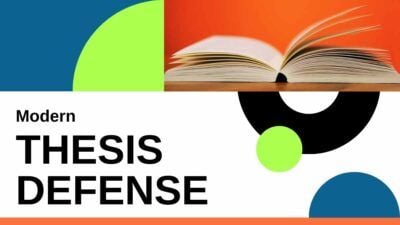
Modern Minimal Thesis Defense Slides
Explore your research findings or educate your audience using this thesis defense Powerpoint and Google Slides template. Designed for high ... Read more
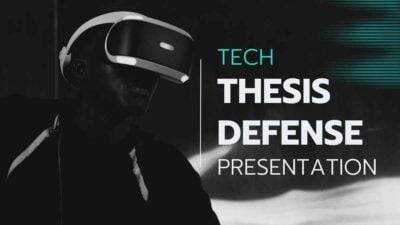
Futuristic Tech Thesis Defense Slides
Make a strong impression at your thesis defense with our sleek, futuristic PowerPoint and Google Slide templates. Perfect for high ... Read more

Pastel Thesis Defense Slides
Capture your educators’ attention with this creatively illustrated Powerpoint and Google Slides template suitable for any thesis defense or project ... Read more
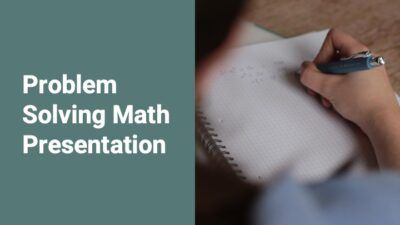
Problem solving Slides
This simple, green and yellow Problem Solving template comes with all the basics and more: agendas, timelines, statistical figures, graphs ... Read more
Professional designs for your presentations
SlidesCarnival templates have all the elements you need to effectively communicate your message and impress your audience.
Suitable for PowerPoint and Google Slides
Download your presentation as a PowerPoint template or use it online as a Google Slides theme. 100% free, no registration or download limits.
- Google Slides
- Editor’s Choice
- All Templates
- Frequently Asked Questions
- Google Slides Help
- PowerPoint help
- Who makes SlidesCarnival?

Problem solving
Sep 11, 2014
530 likes | 1.29k Views
Problem solving. Harapan. MASALAH?. Kenyataan. Hal/ kejadian yang tidak sesuai/ menyimpang dari harapan/ norma/ standar. LANGKAH-LANGKAH. 1. IDENTIFIKASI MASALAH. TUJUAN. Memahami masalah secara jelas dan spesifik Mempermudah penetuan prioritas masalah
Share Presentation

Presentation Transcript
Harapan MASALAH? Kenyataan Hal/ kejadian yang tidak sesuai/ menyimpang dari harapan/ norma/ standar
LANGKAH-LANGKAH 1. IDENTIFIKASI MASALAH TUJUAN • Memahami masalah secara jelas • dan spesifik • Mempermudah penetuan prioritas • masalah • Mempermudah penentuan • alternatif pemecahan masalah
IDENTIFIKASI MASALAH • Kegiatan untuk mengenal dan menyata • kan secara spesifik & kuantitatif gap • (masalah) yang ada (dialami) • Perlu dilakukan analisis situasi yang • tepat • Metode dapat dilakukan dengan: • - Brain storming • - Konfirmasi dengan data • - Problem statement
IDENTIFIKASI MASALAH DENGAN MENGGUNAKAN PENDEKATAN MUTU DAPAT DILAKUKAN BERDASARKAN PENDEKAT-AN SISTEM : 1. Input (masukan) pelayanan 2. Proses pelayanan 3. Out-put pelayanan 4. Out-come pelayanan Menurut Donabedian, identifikasi masalah dg menggunakan pendekatan mutu sebaiknya dilakukan pada tahap Out Come
2. PRIORITAS MASALAH Penentuan prioritas masalah sangat berguna Untuk alokasi sumber daya. Masalah yang mempunyai prioritas tinggi perlu mendapat Aloksi sumber daya tinggi. Penentuan prioritas dpt dilakukan dg.: MetodeMCUA Delphi Delbeque Dll.
Metode MCUA (Multiple Criteria Utility Assessment) Memperhitungkan Bobot dan Skor Bobot untuk menilai kriteria dan Skor untuk menilai masalah Kriteria yg digunakan adalah kriteria dampak, Contoh: Urgensi (tk.kepentingan) dari mas., seriousness (tk. keparahan), Growth, Akibat terhdp. pasien, Akibat thd. masy., dll. Besar nilai bobot adalah 1 – 5 Besar nilai skor adalah 1 – 10 Nilai bobot dikalikan dengan skor untuk setiap masalah, kemudian hasilnya dijumlah ke bawah. Nilai yang paling besar jumlahnya mendapat prioritas pertama
MCUA: • Kriteria batasan untuk menyaring alternatif2 sesuai kebutuhan • Contoh kriteria untuk menetapkan prioritas masalah USG : • Urgency ( mendesak ) • Seriousness ( kegawatan ) • Growth ( meluas ) Kriteria lain untuk masalah manajemen misalnya: kerugian bagi masy. luas, komitmen politis, kemampuan teknologi dan SDM, dll.
Prioritas Masalah dgnMetoda Pembobotan (MCUA) Masalah C dengan Total Skor tertinggi Prioritas Masalah Bobot : 1 – 5 Skor : 1 - 10
METODE DELBEQUE & DELPHI Delbeque: Kualitatif oleh panel ahli secara tertutup Urutan prioritas dibahas kembali Konvergensi Pendapat Konsensus Delphi Diskusi terbuka oleh panel ahli Konsensus
3. MENETAPKAN MASALAH • Kuantitatif • Operasional • 3W 1 H (What, Where, When, How much) • Tidak menyalahkan seseorang, tidak mengungkapkan penyebab dan tidak menyebut pemecahan yg. diinginkan
CONTOH: PENETAPAN MASALAH • Prevalensi penyakit TB di wilayah kerja Puskesmas Mawar pada akhir tahun 2008 sebesar 2,4 per seribu penduduk. • Anak balita yang menderita kekurangan gizi (bawah garis merah) pada akhir tahun 2008 di wilayah kerja Puskesmas X sebesar 5 % dari jumlah anak balita yang ada.
4. MENENTUKAN PENYEBAB MASALAH Masalah yang sudah ditetapkan atau dirumuskan, selanjutnya dapat pula dicari faktor penyebabnya dengan menggunakan fishbone diagram (diagram tulang ikan) Alat/sarana Proses MASALAH Manusia Lingk.
LANGKAH-LANGKAH Rumusan pernyataan masalah ditempat kan pada kepala ikan Untuk pola berfikir, gunakan pendekat- an sistem (INPUT, PROSES, OUTPUT, OUTCOME). Lakukan curah pendapat (brain storming) untuk menentukan penyebab Konfirmasi penyebab masalah dengan data sekunder atau data primer guna menetapkan akar penyebab yang sebenarnya.
5. MENENTUKAN PENYEBAB DOMINAN Dilakukan setelah konfirmasi penyebab masalah dengan data sekunder/ data primer Alat bantu/ metode yang digunakan adalah argumentasi/ justifikasi Cara yang terbaik adalah dengan menggunakan diagram Pareto
6. ALTERNATIF PEMECAHAN MASALAH Jika penyebab sudah jelas maka dapat langsung mengidentifikasi alternatif pemecahan masalah Apabila pemecahan tidak jelas, tulis penyebab masalah yang sudah dipilih Gunakan metode curah pendapat untuk menggali alternatif pemecahan masalah dengan mencoba melihatnya dari berbagai sudut pandang (mis. sudut pandang pasien, tokoh masyarakat, petugas, pemerintah daerah, dll.)
7. PENETAPAN PEMECAHAN MASALAH TERPILIH Kriteria yg digunakan berbeda dengan kriteria untuk menetapkan masalah Kriteria lebih menekankan pd. harapan akan keberhasilannya, mudah dilaksana kan, murah biayanya, singkat waktunya, komitmen petugas,tersedianya teknologi, dll.) Gunakan 3 – 5 kriteria. Cara sama dengan penetapan masalah terpilih.
8. PENYUSUNAN RENCANA PENERAPAN PEMECAHAN MASALAH Penyusunan rencana dapat dbuat dengan menggunakan Gantt Chart, dengan item: nomor, kegiatan, tujuan, sasaran, waktu, pelaksana, biaya yang dibutuhkan, indikator keberhasilan. Perlu mempertimbangkan kemungkinan adanya faktor penghambat dan faktor pendukung (Force-Field Diagram) dalam pemilihan alternatif pemecahan masalah
PENYUSUNAN RENCANA PENERAPAN PEMECAHAN MASALAH DAPAT MENGACU KEPADA PROGRAM DAN KEGIATAN YANG ADA Program adalah kumpulan dari berbagai kegiatan Untuk Puskesmas sudah ada 6 program pokok dan 1 program pengembangan (inovasi) Tentukan program yang akan mendukung pencapaian tujuan
PENYUSUNAN KEGIATAN Kegiatan adalah penjabaran dari program yang ada Kenapa kegiatan itu penting Apa tujuan kegiatan tersebut Dimana kegiatan akan dilakukan Kapan kegiatan di adakan Siapa yg mengadakan & siapa sasarannya & berapa banyak Bagaimana seharusnya kegiatan tsb. dilaksanakan
PENYUSUNAN KEGIATAN Kegiatan yang disusun merupakan penjabaran dari program yang ada dengan memperhatikan kebijakan yang ada: Menyusun kegiatan berarti melakukan alternatif pemecahan masalahuntuk mencapai tuj. yang sudah ditentukan Untuk menentukan alternatif pemec. masalah perlu pemahaman akan mas. yang ada & pemahaman sub sistem masalah (faktor determinan atau penyebab masalah)
Masing-masing alternatif/ kegiatan, pertimbangkan: • Relevansi hasil (output) alternatif dg. tuj. pemecahan masalah (dapat mengurangi/ menyelesaikan masalah yang dihadapi • Evektivitas • Relatif cost (benefit cost) • Technical Feasibility (dpt dijalankan/tdk.) • Sumber daya • Keuntungan dan kerugian • Faktor penghambat & pendukung
Penyusunan kegiatan harus memperhatikan Kebutuhan Sumber Daya: Tenaga (jenis, jumlah, pengetahuan, keterampilan & sikap) Menghitung jumlah tenaga (berdasarkan rasio pddk & tenaga, berdasarkan target, dll) Perlengkapan - Barang apa yg benar-benar diperlukan - Mengapa barang tsb diperlukan - Dimana dan kapan dibutuhkan - Biaya yang dibutuhkan - Cara pengaadaan yg menguntungkan - Siapa yg akan mengurus barang, dsb.
9. PELAKSANAAN /IMPLEMENTASI KEGIATAN Setelah merencanakan tahap-tahap penerapan, tim mutu dapat melaksanakan sesuai rencana penerapan yang telah disepakati.
10. MONITORING & EVALUASI Hal-hal yang perlu dimonitor: - Jenis Kegiatan - Waktu pelaksanaan - Waktu kegiatan berakhir - Pelaksanaan Kegiatan - Prosedur pelaksanaan - Hasil yang dicapai Untuk melakukan pengkajian diperlukan standar dan indikator
Siklus Problem Solving Mengenal Masalah Merencanakan Pemecahan Pemilahan Masalah Menetapkan Prioritas
Evaluasi Prioritas Masalah Controlling Tujuan Monitoring Pelaksanaan&Penggerakan Alternatif Pemecahan Masalah Rencana Operasional Problem Solving Cycle (SiklusPemecahanMasalah). Analisis Situasi Identifikasi Masalah
TERIMA KASIH WASSALAMUALAIKUM WW
- More by User


Problem Solving
Problem Solving. Shortcuts through the Problem Space. Problem Solving. Problem = a situation in which one is trying to reach a goal Problem solving = finding a means for arriving at a goal. Stages of Problem Solving. Define the problem -- Problem identification and representation
853 views • 13 slides
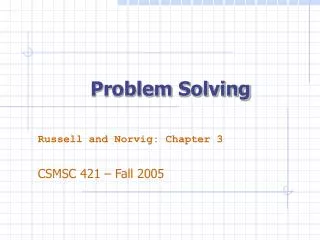
Problem Solving. Russell and Norvig: Chapter 3 CSMSC 421 – Fall 2005. sensors. environment. ?. agent. actuators. Problem-Solving Agent. sensors. environment. ?. agent. actuators. Formulate Goal Formulate Problem States Actions Find Solution. Problem-Solving Agent.
1.06k views • 72 slides

Problem solving. Problem solving: cognitive processes focused on achieving a specific goal. Strategies of problem solving: Trial and error, algorithms and heuristics Ill-defined vs. Well-defined problems. Heuristics vs. algorithms.
594 views • 22 slides

Presentation of Engineering Solutions . As a pair, in the next 5 minutes review the contents of Supplement_3a.ppt (Note: This material was taken from Chapter 3.4 of Foundations of Engineering). . . Engineers Solve Problems. Problem solving is a powerful human activity. Computers are useful to
212 views • 11 slides

Session Overview. Manatee Core Curriculum*K12CRBRP and the 90 Minute Reading Block*Universal Screeners and RtIDistrict Universal ScreenersMedian ScoresGap AnalysisProgress Monitoring*. Manatee Core Curriculum (MCC). K 5 in Math, Music, Reading, Science, Social Studies, and Writing6 12
428 views • 30 slides

Problem Solving. GXEX1406 Thinking and Communication Skills. Terminology of Problem Solving. Seven terms of terminology to be understand are: 1. Purpose What we want to do or what we want to be. Without clear purposes, we cannot think about problems. 2. Situation What a circumstances is.
305 views • 14 slides

Problem Solving. Cadre 9 Initial Training November 5 th , 2013. Acknowledgements. Florida Problem Solving & Response to Intervention Project Heartland Area Education Agency 11. Trying to make good decisions for our students can feel like this…. The Problem Solving Process.
578 views • 32 slides

Problem Solving . A Pilot Programme with second-year students Seamus Knox (DES) Fiona Lennon (PMDT) Tony Knox ( PMDT) Johnny Flaherty ( PMDT). Introduction. Background Purpose Introduce students to collaborative problem solving Motivate curricular content
308 views • 17 slides

Problem solving . Problem 1:. You system doesn’t power up. Solution 1:. Check to see if your computers plugged in. If your computer is plugged into a UPS or surge protector, make sure that it is turned on. Check to make sure that all the components are properly connected.
312 views • 21 slides

PROBLEM-SOLVING
PROBLEM-SOLVING. The SMART way FACTOR-LABEL (aka DIMENSIONAL ANALYSIS). Solve in 5 minutes. An ancient measurement of volume mentioned in the Bible is the EPHAH. CHALLENGE: You have 5 minutes to figure out how many liters are equal to an ephah , using the following information:
249 views • 17 slides

PROBLEM SOLVING
PROBLEM SOLVING. What is the role of the teacher?.
253 views • 15 slides

Problem Solving. Establishing a culture of thinking in your class. Problem Solving & Modelling.
496 views • 33 slides

Problem Solving. A Window on Thinking. Research Methods. Variables of Interest Kinds of Problems Kinds of Subjects Evaluate: Answers for types of errors Time Strategies used by subjects to solve problems A word on Introspection. Solution Paths. Algorithms Heuristics.
261 views • 18 slides

Problem Solving. Professor: Dr. Miguel Alonso Jr. Outline. Analytic and Creative Problem Solving Analytic Problem Solving Creative Problem Solving Personal Problem Solving Brainstorming Strategies Critical Thinking. Analytic and Creative Problem Solving.
560 views • 17 slides

Problem Solving. Solve this maze at your leisure.
483 views • 37 slides

PROBLEM SOLVING. Payback Period. PDAF Ltd. A manufacturing company is faced with the problem of choosing between two mutually exclusive projects. Project A requires a cash outlay of P2,500,000 and generates a net cash flow of P1,000,000 per year for 4 years.
266 views • 24 slides

Problem Solving. Kimberley Clow [email protected] http://instruct.uwo.ca/psychology/130. Outline. Learning vs. Thinking Stages in Creative Thinking Preparation Incubation Illumination Verification Hindrances to Problem Solving Process of Problem Solving Methods of Problem Solving
420 views • 38 slides

Problem Solving. Steps in solving problems. Read the whole problem CAREFULLY! Write down or underline the KEY WORDS Decide the CALCULATION you need to do ESTIMATE your answer Write down the SUM CHECK YOUR ANSWER MAKES SENSE. Question 1.
134 views • 12 slides

Problem Solving and Programming – Problem Solving
Dr Scott Turner. Problem Solving and Programming – Problem Solving. Why do you needed to develop problem solving skills?. One definition of programming is it is applied problem solving You have a problem (E.g Need a program to calculate the area of the circle). What needs to be done?
695 views • 29 slides

Problem Solving. From Conceptual Blockbusting , 4 th Edition, by James L. Adams. Solve This Puzzle.
180 views • 17 slides

Problem Solving. Jan Sands KESAM 2006 Sources: Dr. Grayson Wheatley, AIMS, Connected Math. Problem solving is…. In problem solving the answer is not apparent. Problem solving is what you do when you don’t know what to do. If you know how to get an answer, it is not problem solving.
221 views • 19 slides
Got any suggestions?
We want to hear from you! Send us a message and help improve Slidesgo
Top searches
Trending searches

26 templates

102 templates

15 templates

49 templates

cyber security
9 templates

386 templates
Problem Solving Lesson
It seems that you like this template, problem solving lesson presentation, free google slides theme, powerpoint template, and canva presentation template.
To have a better experience when teaching little kids at school, you can use resources such as slideshows so they keep focused on the lecture. Start editing this template containing pastel colors and simplified layouts! It's not focused on any subject in particular, so you can get the most of it by modifying according to the lesson you need to give.
Features of this template
- 100% editable and easy to modify
- 25 different slides to impress your audience
- Available in five colors: yellow, blue, pink, green, purple
- Contains easy-to-edit graphics such as graphs, maps, tables, timelines and mockups
- Includes 500+ icons and Flaticon’s extension for customizing your slides
- Designed to be used in Google Slides, Canva, and Microsoft PowerPoint
- 16:9 widescreen format suitable for all types of screens
- Includes information about fonts, colors, and credits of the free resources used
How can I use the template?
Am I free to use the templates?
How to attribute?
Attribution required If you are a free user, you must attribute Slidesgo by keeping the slide where the credits appear. How to attribute?
Available colors.
Original Color
Related posts on our blog

How to Add, Duplicate, Move, Delete or Hide Slides in Google Slides

How to Change Layouts in PowerPoint

How to Change the Slide Size in Google Slides
Related presentations.

Premium template
Unlock this template and gain unlimited access

Register for free and start editing online
Empowering Steps in Problem Solving _ Materi Training "Mastering Problem & Analysis"

Narasumber; Kanaidi, SE., M.Si., cSAP HP. 0812 2353 284, WA.: 0877 5871 1905 e-mail : [email protected] atau [email protected] --------------------------------------------- Read less
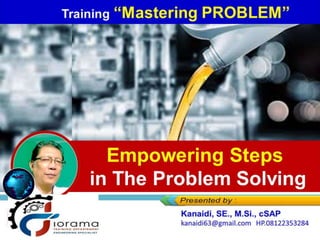
Recommended
More related content, what's hot, what's hot ( 16 ), similar to empowering steps in problem solving _ materi training "mastering problem & analysis", similar to empowering steps in problem solving _ materi training "mastering problem & analysis" ( 20 ), more from kanaidi ken, more from kanaidi ken ( 20 ), recently uploaded, recently uploaded ( 20 ).
- 1. Empowering Steps in The Problem Solving Training “Mastering PROBLEM”
- 2. “He who asks a question may be a fool for five minutes, but he who never asks a question remains a fool forever.” - Tom Connelly “Yangbertanyabisajadi dianggapbodohselama lima menit,tapiyangtidakpernahbertanyatetapbodoh selamanya.”
- 3. Barriers to EffectiveProblem Solving • Failure to recognize the problem • Conceiving the problem too narrowly • Making a hasty choice • Failure to consider all consequences • Failure to consider the feasibility of the solution XX• Gagal mengenali masalahnya • Memahami masalahterlalu sempit • Membuat pilihanyang terburu-buru • Kegagalanuntuk mempertimbangkan semua konsekuensi • Kegagalanuntuk mempertimbangkan kelayakansolusi.
- 4. 1. Identify the Problem. (Write your Problem) 2. List All Possible Solutions. 3. Evaluate Each Option and Select Best Choice 4. Take Action.
- 5. 1. Take Action 2. Empowering 3. Evaluate the Effectiveness of the Decision Empowering Steps in The Problem Solving
- 6. Take Action • (Write the action you plan to take. What will you do?) a. When will you start or try this plan? (date/time) b. Who will you talk to about your plan? (list names)
- 7. Take Action … • Langkah ini seringkali sangat sulit, maka dibutuhkan dukungan dan penguatan. • Manajer bisa membantu memfasilitasi upaya pemberdayaan dengan mendorong pelaksana yang ditunjuk untuk bertanggung jawab dalam pemecahan masalah yang direncanakan. • Perhatikan lagi: ❖ Action plan ❖ Resources required ❖ Appropriate order of activities ❖ Time table for completion ❖ Person(s) responsible
- 8. Empowerment • It is defined as giving employees the authority & information they need to make wise decisions and solve the problems. “The paradox of empowerment is that in order to gain power, you must give some of it away. Good managers are those who recognize that empowerment is not a substitute for leadership or a decrease in their own authority. The more people are empowered, the more they need leaders who can set goals and define a vision of where the org. should be going.” “Paradoks dari empowerment adalah untuk mendapatkan kekuasaan, ini yang harus Anda berikan (sebagian). Manajer yang baik adalah mereka yang menyadari bahwa pemberdayaan bukanlah pengganti kepemimpinan atau penurunan otoritas seorang manajer. Semakin banyak orang diberdayakan, semakin mereka membutuhkan pemimpin yang dapat menetapkan tujuan dan menentukan visi ke mana organisasi seharusnya pergi."
- 9. Evaluate the Effectiveness of the Decision • Dengan memperhatikan: ❖ Outcome objectives met? ❖ Problem solved? ❖ Process improved? ❖ Strategic goal achieved? ❖ If the plan is not being followed as expected, then consider: Was the plan realistic? Are there sufficient resources to accomplish the plan on schedule? Should the plan be changed?
- 10. Evaluate … • Pada fase ini, petugas yang bertanggung jawab diminta untuk mengevaluasi setiap opsi yang ada dalam daftar (dari sesi brainstorming terdahulu). • Petugas yang bertanggung jawab memiliki kesempatan untuk memproyeksikan konsekuensi dari setiap opsi yang ada, mengidentifikasi dan menghilangkan pilihan yang tidak aman atau dianggap bertentangan, sehingga mempersempit daftar solusi yang potensial.
- 11. The Decision-Making Process
- 12. What is Decision Making?
- 13. What are the things you consider before making a decision? What is Decision Making?
- 14. Definition Decision Making: The cognitive process leading to the selection of some action among alternatives. or The process of examining your possibilities options, comparing them, and choosing a course of action.
- 15. Six C's of Decision Making (1 of 2) Construct a clear picture of precisely what must be decided. Compile a list of requirements that must be met. Collect information on alternatives that meet the requirements.
- 16. Six C's of Decision Making (2 of 2) Compare alternatives that meet the requirements. Consider the "what might go wrong" factor with each alternative. Commit to a decision and follow through with it.
- 17. Inherent Personal Traps Trying too hard to play it safe. Letting fears and biases tilt your thinking and analysis. Getting lost in the minutia can cause trouble. Craving for unanimous approval. Trying to make decisions which are outside your realm of authority. • Berusaha terlalu keras untukbermain aman. • Membiarkan ketakutandan bias dalam pemikiran dan analisis. • Tersesat dalam hal-halkecilyang dapat menyebabkan masalah. • Mendambakan persetujuan dengan suara bulat. • Mencoba membuat keputusanyang berada di luar kewenangan.
- 18. Inherent System Traps Willing to begin with too little, inaccurate, or wrong information. Overlook viable alternatives or waste time considering alternatives which have no realistic prospects. Not following the six C's. Failure to clearly define the results you expect to achieve. Worst of all, failure to reach a decision. • Bersediamemulaidenganinformasiyangterlalusedikit,dangkal, tidakakurat,atausalah. • Mengabaikanalternatifyanglayakataubuangwaktudengan mempertimbangkanalternatifyangtidakmemilikiprospek realistis. • TidakmengikutiSix’C. • KegagalanuntuksecarajelasmendefinisikanhasilyanginginAnda capai. • Yangterburuk,kegagalan untukmengambilkeputusan.
- 19. Barriers to GoodDecision Making "Pemimpin yang sukses memiliki keberanian untuk mengambil tindakan sementara yang lain ragu."
- 20. Barriers to Good Decision Making Hasty - Making quick decisions without having much thought. Narrow - Decision making is based on very limited information. Scattered - Our thoughts in making decisions are disconnected or disorganized. Fuzzy - Sometimes, the lack of clarity on important aspects of a decision causes us to overlook certain important considerations.
- 21. The Decision-Making Process
- 22. What is the process of the Decision-Making ? 1. Identify the problem 3. Consider consequences of each alternative 4. Select the best course of action 5. Evaluate the results 2. Gather information and list possible alternatives
- 23. 1. Identify the problem • What is the problem?: …………………… Semakin spesifik definisi Anda tentang keputusan apa yang akan dibuat, maka harus semakin jelas analisis Anda sehingga akan semakin besar kemungkinannya untuk berhasil.
- 24. • What : Data & Informasi? • Why? Pengambil keputusan yang sukses adalah yang mampu mengeksplorasi semua kemungkinan pilihan dan situasi. 2. Gather information and list possible alternatives • What : Data & Informasi? • Why? Pengambil keputusan yang sukses adalah yang mampu mengeksplorasi semua kemungkinan pilihan dan situasi.
- 25. 3. Consider consequences of each alternative 1. Why? + – 2. Why? + – 3. Why? + – Analisis keuntungan dan kerugian dari setiap alternatif. Dalam banyak kasus, ada kemungkinan terdapat kekurangan informasi yang memadai untuk membuat keputusan yang tepat. 1. Why? + – 2. Why? + – 3. Why? + – Analisis keuntungan dan kerugian dari setiap alternatif. Dalam banyak kasus, ada kemungkinan terdapat kekurangan informasi yang memadai untuk membuat keputusan yang tepat.
- 26. 4. Select the best course of action • Why ? • Dari kesemua yang ada di langkah sebelumnya: pilih salah satu alternatif, yang merupakan kesimpulan yang dapat meyakinkan bahwa itu adalah pilihan "terbaik" Anda. • Dari kesemua yang ada di langkah sebelumnya: pilih salah satu alternatif, yang merupakan kesimpulan yang dapat meyakinkan bahwa itu adalah pilihan "terbaik" Anda.
- 27. 5. Evaluate the results • When? • Where? • Whom? Setelah Anda menetapkan pilihan terbaik, Anda perlu mengembangkan dan menerapkan rencana berupa tindakan yang spesifik dan konkret. Nantinya, ketika Anda mulai melakukan langkah- langkah dalam rencana Anda tersebut, lakukan evaluasi agar Anda menemukan adanya penyesuaian yang perlu dibuat.
- 28. www.slideshare.net/kenkanaidi (Narasumber) www.ken-spektakuler.blogspot.com e-mail: [email protected] atau [email protected] Fax. 022-4267749 HP. 0812 2353 284 WA. 0877 5871 1905 www.antawijaya.com

IMAGES
VIDEO
COMMENTS
Scientific Problem Solving. Scientific Problem Solving. The 4 Step Method. Objective. The learner will be able to describe the purpose and requirements for each of the 4 main steps in the technique for problem solving. Overview. Step 1: "Show What You Know" Step 2: "Isolate" Step 3: "Plug-n-Play" Step 4: "Solve" 611 views • 34 ...
Scientific problem solving. Nov 25, 2012 • Download as PPSX, PDF •. 3 likes • 4,612 views. Kangen Pelangi. Just Real; Education. 1 of 10. Download now. Scientific problem solving - Download as a PDF or view online for free.
The Scientific Method involves a series of steps that are used to investigate a natural occurrence. We shall take a closer look at these steps and the terminology you will need to understand before you start a science project. Problem/Question. Observation/Research. Formulate a Hypothesis.
Dec 2, 2008 • Download as PPT, PDF •. 133 likes • 294,005 views. Andrew Schwartz. Problem Solving PowerPoint Presentation Content slides include topics such as: teaching problem solving skills, evaluating how you solve problems, understanding the process: how to solve problems, 8 active listening techniques, primary issues for problem ...
6 Steps to the Scientific Method: 1) Problem. The question or problem is based on observations. Example: My neighbor's plants growing. better than mine. The Scientific Process: 6 Steps to the Scientific Method: 2) Research. Explore resources that may have information about that question or problem.
SCIENTIFIC PROBLEM SOLVING.pptx - Download as a PDF or view online for free. SCIENTIFIC PROBLEM SOLVING.pptx - Download as a PDF or view online for free ... MATERI LANDASAN PENDIDIKAN PROF MARYONO Pipit Wijaya ... PPT PERUBAHAN LINGKUNGAN MATA PELAJARAN BIOLOGI KELAS X.pptx.
An organized plan for gathering, organizing, analysing, and communicating data A basic set of procedures that scientists use to answer a question or solve a problem 3 The Steps The exact wording can vary, but the basic steps and order should always be followed in an experiment
Publish results (write a lab report, share information with other scientists, repeat experiment) The scientific method is really just organized common sense. If you want to solve a problem, you make observations about the nature of the problem, think of possible solutions, and then test those possible solutions until the problem is solved.
Scientific Problem Solving 2 Recognize the Problem The first step in using a scientific approach to solving a problem is recognizing a problem. A scientific problem is a question that can be answered using scientific methods. To solve a problem, scientists must do research using various sources of information.
Introduction to Engineering Problem Solving and the Scientific Method Adapted from: Dr. Mark Henderson - Arizona State University * Properties of a Problem You have all the information It can be solved Probably one correct answer Engineering Problems Never have all the information It may never have been solved and may not be able to be solved Many solutions So, how do we approach an ...
What is the Scientific Method? *An orderly approach to learning information and solving problems *Similar to problem solving in day to day life, but more consistent *Consists of a problem, hypothesis, materials, procedures, data, and a conclusion To table of contents Why Use the Scientific Method?
Download ppt "Scientific Problem Solving" Similar presentations . Exploring Physical Science. Chemistry UNIT 1. Susie Smith August, 2010 Chemistry is the study of matter. Unit 1 Introduction Chapter 1. Scientific Measurements. Chapter 1 The Nature of Science. I. How Science Works Science - the process of trying to understand the world Science ...
Title: Scientific Thinking and Problem Solving 1 Scientific Thinking and Problem Solving. No way of thinking or, however ancient, can be trusted without proof. Henry David Thoreau ; 2 What is Science. The exploration of nature ; Scientists look for organization in nature and try to explain it. Science does not absolutely prove anything - only
Khusus terkait dg pemecahan masalah anak, maka setiap pamong haruslah memiliki 3 ketrampilan dasar, yaitu: • Problem solving, yaitu kemampuan, sikap, keyakinan dan kepekaan dalam mengenali masalah, merumuskan masalah dan mem-bersihkan inti masalah dari polusi ikutannya. • Decision making, yaitu kemampuan, sikap, keyakinan, keberanian dan ...
Scientific Problem Solving. The 4 Step Method. Objective. The learner will be able to describe the purpose and requirements for each of the 4 main steps in the technique for problem solving. Overview. Step 1: "Show What You Know" Step 2: "Isolate" Step 3: "Plug-n-Play" Step 4: "Solve"
The idea of this warm-up is for students to see that the process they follow when solving problems in their everyday lives has similarities with the scientific method: 1. observe the problem. 2. think of what might be causing the problem. 3. test possible solutions until the problem is solved.
Free Google Slides theme, PowerPoint template, and Canva presentation template. Let's make math learning more fun, especially at early levels of education. This new template has some cute illustrations and lots of elements related to math, including backgrounds that look like blackboards. This is a great choice for teachers who want to turn ...
Problem Solving PowerPoint Presentation Content slides include topics such as: teaching problem solving skills, evaluating how you solve problems, understanding the process: how to solve problems, 8 active listening techniques, primary issues for problem solvers, group or individual brainstorming, the problem solving framework, vertical and lateral thinking, adaptors and innovators as problem ...
Pemecahan Masalah (Problem Solving) Oct 31, 2016 • Download as PPTX, PDF •. 19 likes • 32,416 views. H. hasnabstr. Bimbingan Konseling. Education. 1 of 10. Pemecahan Masalah (Problem Solving) - Download as a PDF or view online for free.
Download your presentation as a PowerPoint template or use it online as a Google Slides theme. 100% free, no registration or download limits. Get these problem-solving templates to create effective presentations that offer solutions to any challenge. No Download Limits Free for Any Use No Signups.
Problem solving. An Image/Link below is provided (as is) to download presentation Download Policy: Content on the Website is provided to you AS IS for your information and personal use and may not be sold / licensed / shared on other websites without getting consent from its author. Download presentation by click this link.
Free Google Slides theme, PowerPoint template, and Canva presentation template. To have a better experience when teaching little kids at school, you can use resources such as slideshows so they keep focused on the lecture. Start editing this template containing pastel colors and simplified layouts! It's not focused on any subject in particular ...
8. Empowerment • It is defined as giving employees the authority & information they need to make wise decisions and solve the problems. "The paradox of empowerment is that in order to gain power, you must give some of it away. Good managers are those who recognize that empowerment is not a substitute for leadership or a decrease in their own authority.